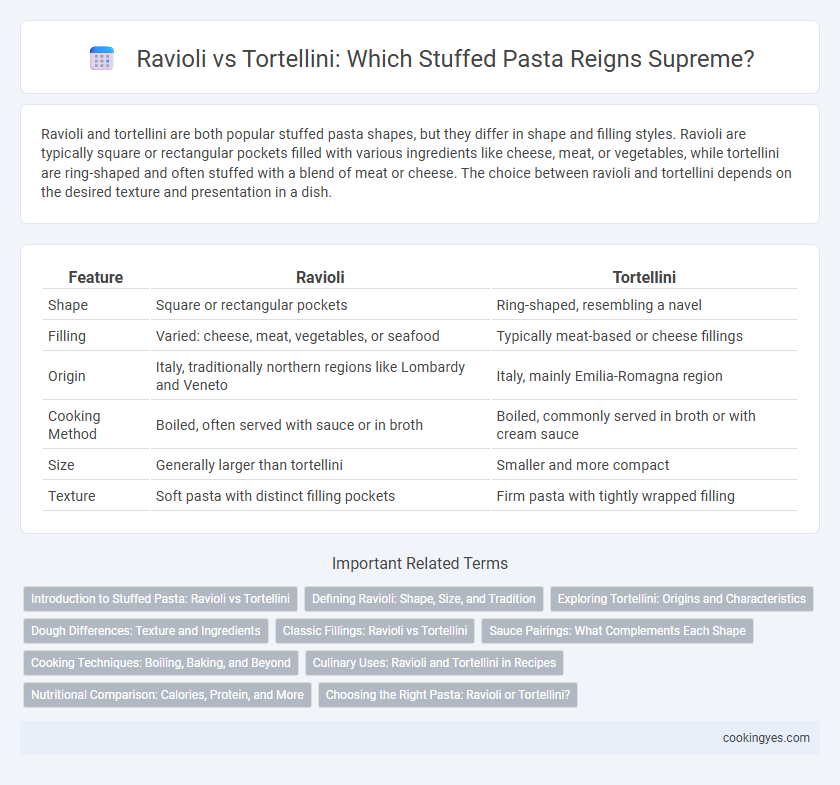Ravioli and tortellini are both popular stuffed pasta shapes, but they differ in shape and filling styles. Ravioli are typically square or rectangular pockets filled with various ingredients like cheese, meat, or vegetables, while tortellini are ring-shaped and often stuffed with a blend of meat or cheese. The choice between ravioli and tortellini depends on the desired texture and presentation in a dish.
Table of Comparison
| Feature | Ravioli | Tortellini |
|---|---|---|
| Shape | Square or rectangular pockets | Ring-shaped, resembling a navel |
| Filling | Varied: cheese, meat, vegetables, or seafood | Typically meat-based or cheese fillings |
| Origin | Italy, traditionally northern regions like Lombardy and Veneto | Italy, mainly Emilia-Romagna region |
| Cooking Method | Boiled, often served with sauce or in broth | Boiled, commonly served in broth or with cream sauce |
| Size | Generally larger than tortellini | Smaller and more compact |
| Texture | Soft pasta with distinct filling pockets | Firm pasta with tightly wrapped filling |
Introduction to Stuffed Pasta: Ravioli vs Tortellini
Ravioli and tortellini are two popular types of stuffed pasta distinct in shape and filling styles; ravioli typically feature square or rectangular pockets filled with ingredients like ricotta, spinach, or meat, while tortellini are smaller, ring-shaped pasta often stuffed with a mix of pork, prosciutto, and cheese. The traditional origins of ravioli trace back to Northern Italy, especially Liguria and Veneto, contrasting with tortellini, which hail from the Emilia-Romagna region, particularly Bologna and Modena. Both pasta shapes offer versatile culinary options, delivering rich flavors through diverse fillings and sauces tailored to their unique textures and forms.
Defining Ravioli: Shape, Size, and Tradition
Ravioli are square or rectangular stuffed pasta pockets typically measuring about 1.5 to 2 inches per side, traditionally filled with a mixture of cheese, meat, or vegetables and sealed with crimped edges. Originating from Italian culinary traditions, ravioli emphasize uniformity in shape and size to ensure even cooking and consistent flavor distribution. Unlike tortellini, which are ring-shaped and smaller, ravioli focus on larger, flat parcels that showcase the filling prominently.
Exploring Tortellini: Origins and Characteristics
Tortellini, originating from the Emilia-Romagna region of Italy, is a ring-shaped stuffed pasta traditionally filled with a mixture of pork, prosciutto, and mortadella blended with Parmesan cheese. Unlike ravioli, which typically features square or circular pockets of filling, tortellini's distinctive shape resembles a small navel and is often served in broth or with cream sauces. The delicate folding technique of tortellini creates a denser texture and richer flavor profile, making it a prized variant in Italian stuffed pasta cuisine.
Dough Differences: Texture and Ingredients
Ravioli dough typically uses a higher ratio of wheat flour and eggs, resulting in a smooth, tender texture that folds easily around fillings. In contrast, tortellini dough is often firmer and rolled thinner, sometimes incorporating water or milk to create a more elastic, slightly chewy consistency. These variations in dough composition directly influence the mouthfeel and structural integrity of each stuffed pasta shape during cooking.
Classic Fillings: Ravioli vs Tortellini
Classic fillings for ravioli typically include ricotta cheese paired with spinach or herbs, offering a creamy texture contrasted by fresh, earthy flavors. Tortellini fillings often feature a mixture of finely ground meats such as pork or prosciutto combined with Parmesan and nutmeg, delivering a rich and savory taste profile. The distinction lies in ravioli's broader, flatter shape accommodating diverse ingredients, while tortellini's smaller, ring-like form concentrates intense, meat-based fillings.
Sauce Pairings: What Complements Each Shape
Ravioli's square shape with larger cavities suits rich, creamy sauces like Alfredo or heavy tomato-based marinara, allowing the filling to blend seamlessly with the sauce. Tortellini's ring shape pairs well with lighter broths, butter sauces, or delicate cream sauces, enhancing the pasta's subtle flavors without overwhelming the filling. Both pasta types benefit from fresh herbs such as sage or basil to elevate the overall taste profile.
Cooking Techniques: Boiling, Baking, and Beyond
Ravioli and tortellini both rely on precise boiling times to achieve perfect al dente texture, typically around 3-5 minutes for ravioli and slightly less for smaller tortellini. Baking ravioli with a rich tomato sauce and cheese creates a crispy, layered casserole, whereas tortellini is often incorporated into creamy soups or baked dishes for added richness. Beyond boiling and baking, techniques like pan-frying ravioli after boiling add a golden, crunchy exterior, while tortellini's compact shape benefits from gentle simmering in broth to preserve its delicate filling.
Culinary Uses: Ravioli and Tortellini in Recipes
Ravioli and tortellini are both popular stuffed pasta shapes that enhance various culinary dishes with their unique textures and fillings. Ravioli typically feature square pockets filled with cheese, meat, or vegetables, ideal for hearty tomato-based sauces or creamy Alfredo. Tortellini, with their ring-shaped form filled often with cheese or prosciutto, excel in broths, light cream sauces, and salads, providing versatility in both soups and pasta dishes.
Nutritional Comparison: Calories, Protein, and More
Ravioli typically contains around 220-250 calories per serving with 8-10 grams of protein, while tortellini offers slightly higher calories ranging from 260-290 with 11-13 grams of protein due to smaller, denser fillings. Both pasta shapes provide comparable amounts of carbohydrates and fat, but tortellini often has higher saturated fat content depending on cheese or meat fillings. Vitamins and minerals such as iron, calcium, and B vitamins vary based on ingredients, making tortellini a marginally richer source of protein and calories compared to ravioli.
Choosing the Right Pasta: Ravioli or Tortellini?
Ravioli features square or round pockets filled with a variety of ingredients, offering a versatile texture that holds well in sauces. Tortellini are smaller, ring-shaped pasta typically stuffed with a meat or cheese mixture, providing a dense, bite-sized option ideal for broths and light sauces. Selecting between ravioli and tortellini depends on the desired sauce pairing and portion size, with ravioli suiting hearty sauces and tortellini excelling in lighter, broth-based preparations.
Ravioli vs Tortellini for stuffed pasta shapes Infographic

 cookingyes.com
cookingyes.com